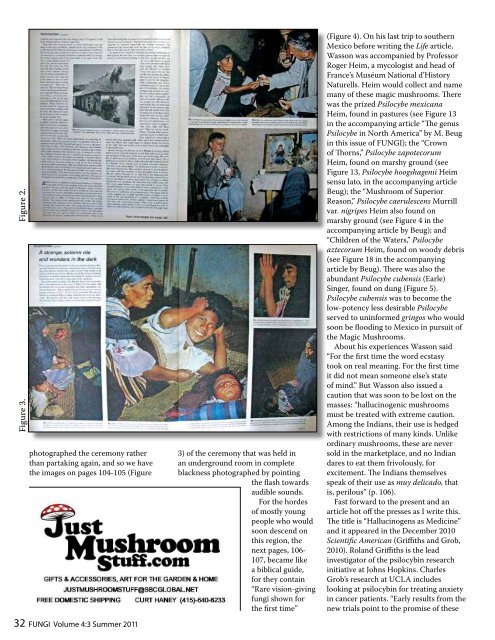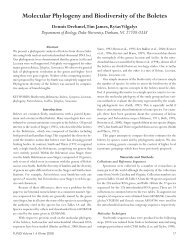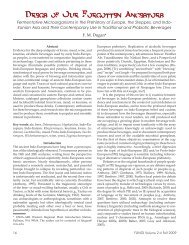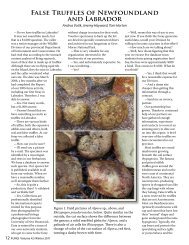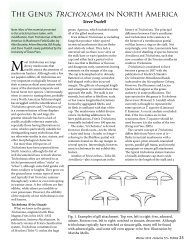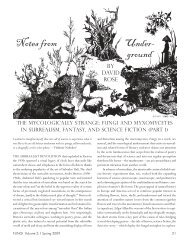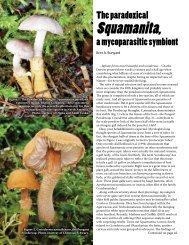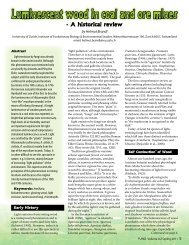History, Personal Stories and Potential Future - FUNGI Magazine
History, Personal Stories and Potential Future - FUNGI Magazine
History, Personal Stories and Potential Future - FUNGI Magazine
You also want an ePaper? Increase the reach of your titles
YUMPU automatically turns print PDFs into web optimized ePapers that Google loves.
Figure 2.<br />
Figure 3.<br />
photographed the ceremony rather<br />
than partaking again, <strong>and</strong> so we have<br />
the images on pages 104-105 (Figure<br />
32 <strong>FUNGI</strong> Volume 4:3 Summer 2011<br />
3) of the ceremony that was held in<br />
an underground room in complete<br />
blackness photographed by pointing<br />
the flash towards<br />
audible sounds.<br />
For the hordes<br />
of mostly young<br />
people who would<br />
soon descend on<br />
this region, the<br />
next pages, 106-<br />
107, became like<br />
a biblical guide,<br />
for they contain<br />
“Rare vision-giving<br />
fungi shown for<br />
the first time”<br />
(Figure 4). On his last trip to southern<br />
Mexico before writing the Life article,<br />
Wasson was accompanied by Professor<br />
Roger Heim, a mycologist <strong>and</strong> head of<br />
France’s Muséum National d’<strong>History</strong><br />
Naturells. Heim would collect <strong>and</strong> name<br />
many of these magic mushrooms. There<br />
was the prized Psilocybe mexicana<br />
Heim, found in pastures (see Figure 13<br />
in the accompanying article “The genus<br />
Psilocybe in North America” by M. Beug<br />
in this issue of <strong>FUNGI</strong>); the “Crown<br />
of Thorns,” Psilocybe zapotecorum<br />
Heim, found on marshy ground (see<br />
Figure 13, Psilocybe hoogshagenii Heim<br />
sensu lato, in the accompanying article<br />
Beug); the “Mushroom of Superior<br />
Reason,” Psilocybe caerulescens Murrill<br />
var. nigripes Heim also found on<br />
marshy ground (see Figure 4 in the<br />
accompanying article by Beug); <strong>and</strong><br />
“Children of the Waters,” Psilocybe<br />
aztecorum Heim, found on woody debris<br />
(see Figure 18 in the accompanying<br />
article by Beug). There was also the<br />
abundant Psilocybe cubensis (Earle)<br />
Singer, found on dung (Figure 5).<br />
Psilocybe cubensis was to become the<br />
low-potency less desirable Psilocybe<br />
served to uninformed gringos who would<br />
soon be flooding to Mexico in pursuit of<br />
the Magic Mushrooms.<br />
About his experiences Wasson said<br />
“For the first time the word ecstasy<br />
took on real meaning. For the first time<br />
it did not mean someone else’s state<br />
of mind.” But Wasson also issued a<br />
caution that was soon to be lost on the<br />
masses: “hallucinogenic mushrooms<br />
must be treated with extreme caution.<br />
Among the Indians, their use is hedged<br />
with restrictions of many kinds. Unlike<br />
ordinary mushrooms, these are never<br />
sold in the marketplace, <strong>and</strong> no Indian<br />
dares to eat them frivolously, for<br />
excitement. The Indians themselves<br />
speak of their use as muy delicado, that<br />
is, perilous” (p. 106).<br />
Fast forward to the present <strong>and</strong> an<br />
article hot off the presses as I write this.<br />
The title is “Hallucinogens as Medicine”<br />
<strong>and</strong> it appeared in the December 2010<br />
Scientific American (Griffiths <strong>and</strong> Grob,<br />
2010). Rol<strong>and</strong> Griffiths is the lead<br />
investigator of the psilocybin research<br />
initiative at Johns Hopkins. Charles<br />
Grob’s research at UCLA includes<br />
looking at psilocybin for treating anxiety<br />
in cancer patients. “Early results from the<br />
new trials point to the promise of these


